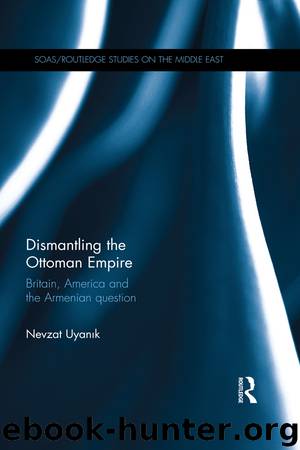Dismantling the Ottoman Empire: Britain, America and the Armenian Question by Uyanık Nevzat

Author:Uyanık, Nevzat [Nevzat Uyanık]
Language: eng
Format: epub
ISBN: 9781317428978
Publisher: Taylor & Francis Ltd
* * *
Muslims 1,375,000 68
Armenians 472,000 23.5
Greeks 153,000 7.5
Others 16,000 1
Table 4.2 Population of the Turkish vilayets proposed for an Armenian mandate at the end of World War I
Nationality Population Percentage (%)
* * *
Muslims 1,101,000 75
Armenians 236,000 16
Greeks 122,000 8
Others 8,000 1
The Harbord report pointed out that there were about half a million Armenian refugees in Caucasia who eventually would want to begin life anew, to which others who might return from other lands would be added. The report also drew attention to the Turkish side of the border where the Armenians had returned and started gradually to recover their property, and in some cases receive rent for it, but generally found things in ruins. The report observed no danger to the Armenians who had returned to their homes in Turkey. Actually, en route from Istanbul to Adana, the Harbord Mission stopped briefly at Izmit, Sapanca, Geyve, Afyon-Karahisar, Akşehir, Konya, and other towns where Armenian repatriates led by priests welcomed the Americans and expressed their hopes. The mission saw in Adana and other towns in Cilicia the work of American relief agencies under British and French supervision in accommodating thousands of Armenians who were brought to the region after the armistice.58
The Harbord report touched scantily upon the plight of the Turks, yet it found the magnitude of the destruction the war had inflicted upon the country appalling: “scarcely a village or city exists which is not largely in ruins … not over twenty percent of the Turkish peasants who went to war have returned.” The report also repeatedly noted “an appalling lack of people, either military or civilian” throughout Turkey. General Harbord stated that as far as the Armenians were concerned, “the Turk has had his day and further uncontrolled opportunity would be denied him.” Harbord finally concluded that a single mandatory for the Ottoman Empire and the Transcaucasia would be the best economic solution, ruling out an option of an Armenia-only mandate as prohibitive under the region’s trying conditions.59
General Harbord also argued that Turkey would not object to a single “disinterested power” taking a mandate over its territory, and even the National Movement under the leadership of Mustafa Kemal Pasha would not object to a single disinterested mandatory, preferably America. Harbord was aware of the evolving situation in Turkey with the growing importance, in a political and military sense, of the National Independence Movement aiming to preserve the unity of Turkey. The fall of the Ferid Pasha Cabinet in October 1919 had already testified to this fact. Harbord arrived in Sivas on September 20, 1919, after the National Congress had just ended at that city. He met Mustafa Kemal two days later. According to Shaw, Kemal told Harbord that Turkey would indeed accept an American mandate if limited to advice.60
In response to Harbord’s stated concern regarding the Armenians, Mustafa Kemal told him that the National Movement would provide full equality for citizens of all races and religions. He also gave Harbord a detailed memorandum about conditions in Turkey and the goals of the National Movement.
Download
This site does not store any files on its server. We only index and link to content provided by other sites. Please contact the content providers to delete copyright contents if any and email us, we'll remove relevant links or contents immediately.
Cecilia; Or, Memoirs of an Heiress — Volume 1 by Fanny Burney(32434)
Cecilia; Or, Memoirs of an Heiress — Volume 2 by Fanny Burney(31871)
Cecilia; Or, Memoirs of an Heiress — Volume 3 by Fanny Burney(31854)
The Great Music City by Andrea Baker(31349)
We're Going to Need More Wine by Gabrielle Union(18967)
All the Missing Girls by Megan Miranda(15571)
Pimp by Iceberg Slim(14393)
Bombshells: Glamour Girls of a Lifetime by Sullivan Steve(13973)
Talking to Strangers by Malcolm Gladwell(13222)
Norse Mythology by Gaiman Neil(13205)
Fifty Shades Freed by E L James(13157)
For the Love of Europe by Rick Steves(12992)
Mindhunter: Inside the FBI's Elite Serial Crime Unit by John E. Douglas & Mark Olshaker(9201)
Crazy Rich Asians by Kevin Kwan(9167)
The Lost Art of Listening by Michael P. Nichols(7406)
Enlightenment Now: The Case for Reason, Science, Humanism, and Progress by Steven Pinker(7234)
The Four Agreements by Don Miguel Ruiz(6631)
Bad Blood by John Carreyrou(6552)
Weapons of Math Destruction by Cathy O'Neil(6146)
